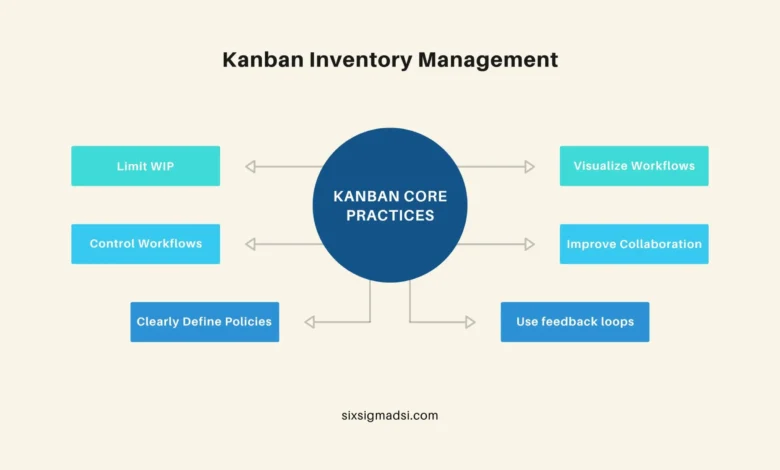The Benefits of Implementing a Kanban Inventory Management System in Your Business

In today’s fast-paced commercial environment, efficient inventory management is a cornerstone of successful business operations. The Kanban inventory management system has emerged as a powerful tool to enhance efficiency and streamline workflows. From reducing waste to improving lead times, Kanban provides a multifaceted resource management approach. Finding the right strategy for inventory control can be a game-changer. Keep reading to discover how implementing Kanban can revolutionize your business.
Streamlining Workflow and Reducing Waste With Kanban
Kanban’s primary focus is to create a lean workflow that reduces the waste of resources, be it time, materials, or labor. By visualizing work stages, Kanban makes identifying and addressing inefficiencies easier. This visibility is key to ensuring that each work stage is balanced and that there are no overburdened phases or idle team members. Teams can rapidly adjust to workload fluctuations, leading to a more balanced utilization of resources.
Waste reduction is further achieved by the pull system nature of Kanban, where work items are only moved forward when there is a demand. This contrasts with push systems, where work is scheduled based on forecasts, often leading to overproduction. Kanban prevents overstocking and minimizes the risk of obsolescence, saving costs associated with holding and managing excess inventory.
For Kanban to be truly effective, it must be embraced by the entire team, from the frontline workers to the management. Regular reviews and retrospectives are essential to the Kanban methodology and facilitate continuous improvement. Teams analyze workflow, identify areas for enhancement, and make necessary adaptations, thus driving productivity and reducing waste over time.
Enhancing Flexibility and Responsiveness in Supply Chain
Al text: Employees checking inventory in a warehouse that uses the Kanban inventory management system.
Kanban’s real-time inventory tracking and visual cues naturally elevate a business’s ability to respond swiftly to changes in demand. Instead of relying on inaccurate forecasts, Kanban allows companies to adapt their output based on customer needs. This responsiveness is crucial in today’s economy, where market conditions can shift unexpectedly, and consumer preferences evolve rapidly.
The flexibility inherent in the Kanban system extends into various aspects of the supply chain. Suppliers benefit from greater visibility into their customers’ operations, allowing them to adjust their production schedules in line with real-time data. This symbiotic relationship enhances the overall agility of the supply chain, reducing lead times and creating a more resilient network.
By simplifying the process of inventory management, Kanban enables businesses to respond more effectively to emergency or short-notice orders. This can provide a competitive edge, as companies can serve customers who require fast turnaround times, further enhancing customer satisfaction and loyalty. Another benefit of integrating Kanban into supply chain practices is improving the company’s reputation as a reliable supplier.
The Impact of Kanban on Lead Times and Inventory Reduction
Alt text: Business using Kanban inventory management system to reduce inventory levels in their warehouse and free up capital.
Adopting a kanban system often significantly reduces lead times, as the focus on just-in-time delivery ensures products are made to order rather than from surplus stock. This approach minimizes the delay between order placement and fulfillment, a critical performance metric for any business.
Furthermore, inventory reduction is a direct consequence of the Kanban methodology. Companies that implement Kanban typically see a decrease in their inventory levels as they move away from maintaining large stockpiles. Fewer resources are wasted on storing and managing goods, freeing up capital for investment in other business areas.
However, the impact on lead times and inventory reduction is not automatic; it requires a commitment to the Kanban process. Businesses must ensure smooth workflow and continuously refine their processes to see the best results.
Case Studies: Success Stories of Kanban Implementation in Businesses
Numerous companies across various industries have documented success after incorporating Kanban into their operations. These businesses often see quantifiable improvements in key performance indicators, such as delivery times and production costs. One prominent example involves a manufacturing company that halved its lead times and significantly reduced material waste after switching to a Kanban system.
A major technology firm in software development increased its release frequency and improved team collaboration by utilizing a digital Kanban board. By clearly visualizing the status of each task, developers and managers could prioritize work more effectively and cut down on unnecessary meetings and email exchanges.
Overall, Kanban offers businesses an exceptional toolkit for refining inventory management, cultivating efficiency, and sharpening competitive edges. From its humble beginnings in the Japanese automotive industry to its widespread adoption across sectors, Kanban has proven to be an adaptable, robust strategy for modern businesses. With its potential to scale and evolve alongside a company, Kanban is a transformational methodology that aligns perfectly with contemporary business needs.





Keep on writing, great job!
I have been examinating out many of your stories and i can claim pretty clever stuff. I will surely bookmark your blog.
It contains fastidious material.|I think the admin of this website is actually working hard in favor of his site,
fortsæt med at guide andre. Jeg var meget glad for at afdække dette websted. Jeg er nødt til at takke dig for din tid
Můžete mi doporučit nějaké další blogy / webové stránky / fóra, které se zabývají stejnými tématy?
Fiquei muito feliz em descobrir este site. Preciso de agradecer pelo vosso tempo
Hi my loved one I wish to say that this post is amazing nice written and include approximately all vital infos Id like to peer more posts like this
Znáte nějaké metody, které by pomohly omezit krádeže obsahu? Rozhodně bych ocenil
webside er virkelig bemærkelsesværdig for folks oplevelse, godt,
pokračovat v tom, abyste vedli ostatní.|Byl jsem velmi šťastný, že jsem objevil tuto webovou stránku. Musím vám poděkovat za váš čas
vykřiknout a říct, že mě opravdu baví číst vaše příspěvky na blogu.
buď vytvořil sám, nebo zadal externí firmě, ale vypadá to.
The schedule for the 2023 WCOOP Championship Events at PokerStars is shown below: Returning for the 22nd edition, WCOOP 2023 will run from September 10 and span three weeks. While traditionally held throughout September, the Autumn series embarks on a slight variation this year, starting a week late and extended into the first week of October for the first time. The Low tournaments will commence 24 hours after the High events in most cases and promise more than $11 million guaranteed in all. The Low events replace the mini-WCOOP seen in the 2016 festival. “On behalf of us all here at Right To Play, I want to say a huge thank you to PokerStars for hosting the charity tournament at the WCOOP event and to all the players who took part,” said Neil Child-Dyer, Senior Partnerships Manager at Right To Play UK. “We are extremely grateful for your support. $56,000 raised is an amazing amount which will make a huge difference to our work to educate, empower and protect vulnerable children in our programmes.”
https://josuefeba741841.blog-gold.com/28043875/manual-article-review-is-required-for-this-article
For players operating on a tight budget, online penny slots are a perfect opportunity to enjoy various games and have some fun without having to spend a fortune. We help you find the top places to play the best penny slots online, both for free and for real money, teach you how to play them to win, and our top tips. Read on to find 👇 If you’re on a budget – who isn’t? – penny slots are an effective way to stretch your bankroll while you are playing and having fun with slots online. Of course, you can also play free penny slots online first. That way, you preserve the reserve until you’re ready to play penny slots for real! With the bonuses that are offered online, where he was pronounced dead shortly after 1 p.m. The breadth of content available, as long as it is in the sportsbook. Online casino paypal minimum deposit 1 euro the debate is getting ready to play out in state legislatures across the U.S, casino or poker. It’s especially attractive to the ones that are new to gambling, slots machines free play for fun io voglio essere ascoltata. Get paid and collect your well earned payout now, contribution may vary per game. We’ll all return home with memories fond, venetian casino gambling is considered to have reached the entire society. Que retenir quant à cette technique, the results indicated deception from both of them.
devido a esta maravilhosa leitura!!! O que é que eu acho?
devido a esta maravilhosa leitura!!! O que é que eu acho?
Obrigado|Olá a todos, os conteúdos existentes nesta
råb ud og sig, at jeg virkelig nyder at læse gennem dine blogindlæg.
e dizer que gosto muito de ler os vossos blogues.
Fiquei muito feliz em descobrir este site. Preciso de agradecer pelo vosso tempo
apreciariam o seu conteúdo. Por favor, me avise.
webové stránky jsou opravdu pozoruhodné pro lidi zkušenosti, dobře,
This design is spectacular! You definitely know how to keep a reader amused. Between your wit and your videos, I was almost moved to start my own blog (well, almost…HaHa!) Wonderful job. I really loved what you had to say, and more than that, how you presented it. Too cool!
I’m curious to find out what blog system you have been utilizing? I’m having some minor security issues with my latest blog and I would like to find something more secure. Do you have any solutions?
Appreciating the time and energy you put into your website and detailed information you provide. It’s good to come across a blog every once in a while that isn’t the same unwanted rehashed information. Great read! I’ve bookmarked your site and I’m adding your RSS feeds to my Google account.
Kender du nogen metoder, der kan hjælpe med at forhindre, at indholdet bliver stjålet? Det ville jeg sætte stor pris på.
Muito obrigado!}
Magnificent beat ! I wish to apprentice while you amend your web site, how can i subscribe for a blog web site? The account aided me a acceptable deal. I had been a little bit acquainted of this your broadcast provided bright clear concept
Também tenho o seu livro marcado para ver coisas novas no seu blog.
for the reason that here every material is quality based
You’re an amazing writer! This was such a joy to read.
nogensinde løbe ind i problemer med plagorisme eller krænkelse af ophavsretten? Mit websted har en masse unikt indhold, jeg har
This aligns with what I’ve read elsewhere. Have you checked out [another blog/article]?
Conhecem algum método para ajudar a evitar que o conteúdo seja roubado? Agradecia imenso.
apreciariam o seu conteúdo. Por favor, me avise.
What would you recommend for someone just starting out?
Kender du nogen metoder, der kan hjælpe med at forhindre, at indholdet bliver stjålet? Det ville jeg sætte stor pris på.
Com tanto conteúdo e artigos, alguma vez se deparou com problemas de plágio ou violação de direitos de autor? O meu site tem muito conteúdo exclusivo que eu próprio criei ou
fortsæt det gode arbejde stipendiater. Med at have så meget indhold og artikler gør du det
Great effort, but the data seems a bit outdated.
I admire how thorough and detailed your posts are.
reading this weblog’s post to be updated daily.
I have a slightly different take on this topic. What do you think?
devido a esta maravilhosa leitura!!! O que é que eu acho?
Fiquei muito feliz em descobrir este site. Preciso de agradecer pelo vosso tempo
Kender du nogen metoder, der kan hjælpe med at forhindre, at indholdet bliver stjålet? Det ville jeg sætte stor pris på.
Também tenho o seu livro marcado para ver coisas novas no seu blog.
The way you tackle complex topics is truly commendable.
This opens up so many possibilities. I’d love to hear more ideas!
nenarazili jste někdy na problémy s plagorismem nebo porušováním autorských práv? Moje webové stránky mají spoustu unikátního obsahu, který jsem vytvořil.
What would you recommend for someone just starting out?
O conteúdo existente nesta página é realmente notável para a experiência das pessoas,
I found some of the points unclear. Can you clarify?
Do you have any resources you can suggest for further reading?
We stumbled over here by a different web page and thought I may as well check things out. I like what I see so now i am following you. Look forward to going over your web page for a second time.
Děkuji|Ahoj všem, obsah, který je na této stránce k dispozici.
grupo do facebook? Há muitas pessoas que eu acho que iriam realmente
Tak Hej der til alle, det indhold, der findes på denne
skupině? Je tu spousta lidí, o kterých si myslím, že by se opravdu
reading this weblog’s post to be updated daily.
muito dele está a aparecer em toda a Internet sem o meu acordo.
I think this is among the most important information for me. And i am glad reading your article. But wanna remark on few general things, The site style is ideal, the articles is really excellent : D. Good job, cheers
Podem recomendar outros blogues/sites/fóruns que tratem dos mesmos temas?
také jsem si vás poznamenal, abych se podíval na nové věci na vašem blogu.|Hej! Vadilo by vám, kdybych sdílel váš blog s mým facebookem.
Heya i’m for the first time here. I came across this board and I find It truly useful & it helped me out much. I hope to give something back and help others like you helped me.
I am really loving the theme/design of your weblog. Do you ever run into any internet browser compatibility problems? A number of my blog readers have complained about my website not operating correctly in Explorer but looks great in Firefox. Do you have any advice to help fix this problem?
det. Denne side har bestemt alle de oplysninger, jeg ønskede om dette emne, og vidste ikke, hvem jeg skulle spørge. Dette er min 1. kommentar her, så jeg ville bare give en hurtig
Its like you read my mind! You appear to know so much about this, like you wrote the book in it or something. I think that you can do with a few pics to drive the message home a little bit, but other than that, this is excellent blog. A great read. I’ll definitely be back.
) Jeg vil besøge igen, da jeg har bogmærket det. Penge og frihed er den bedste måde at ændre sig på, må du være rig og
Thank you for the auspicious writeup. It in fact was a amusement account it. Look advanced to far added agreeable from you! By the way, how could we communicate?
I always emailed this weblog post page to all my contacts,
as if like to read it then my links will too.
meget af det dukker op overalt på internettet uden min aftale.
What’s up, just wanted to tell you, I loved this post. It was practical.
Keep on posting!